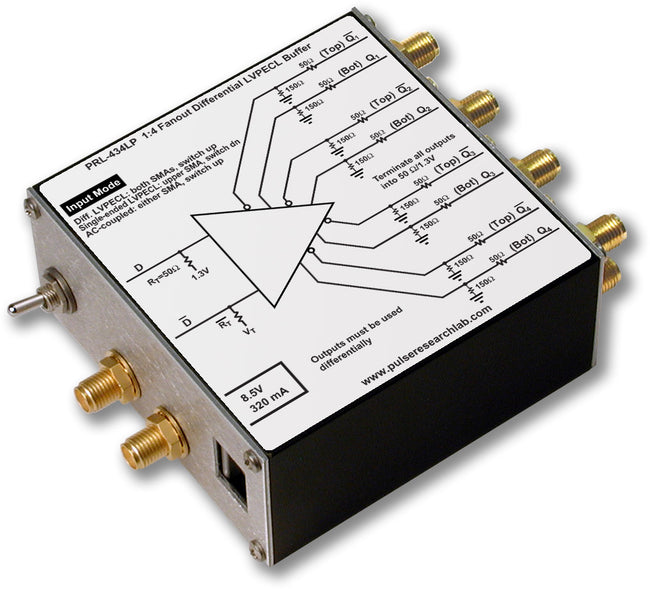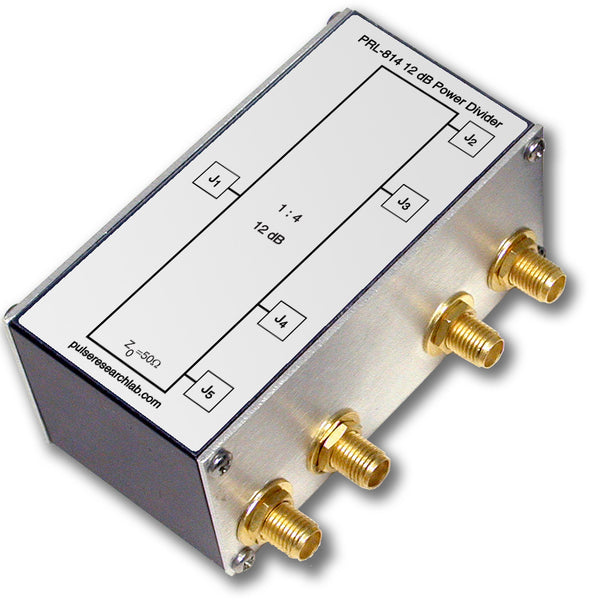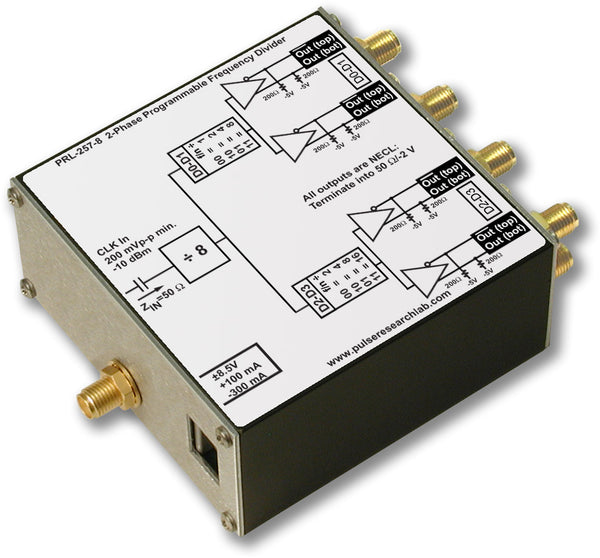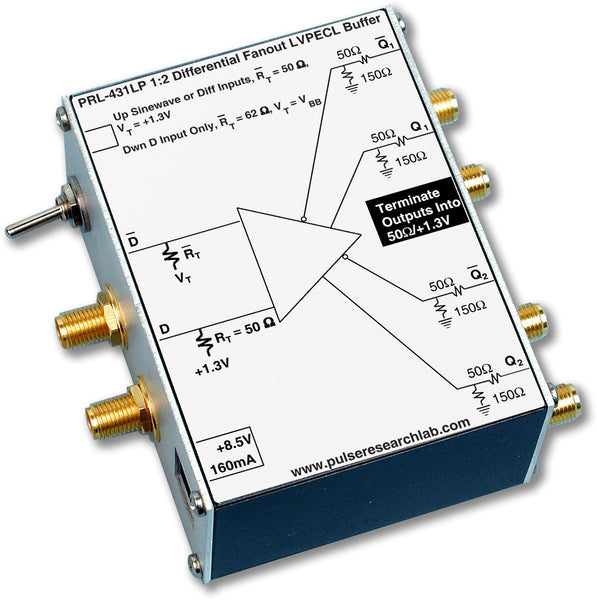Applications:
|
|
Features:
|
|
DescriptionThe PRL-434LP is a 1:4 Differential LVPECL Fanout Buffer module. It is intended for fanning out single-ended or differential LVPECL signals into four pairs of differential outputs. It can also be used for converting AC coupled GHz sinewave or PECL signals into differential LVPECL signals. A switch selects either single-ended or differential inputs, as shown in Fig. 1. In the differential input mode, both inputs D and D are terminated internally into 50 Ω/+1.3 V, and, therefore, either one or both inputs can accept AC coupled signals as well. In the single-ended input mode, signals should be connected to the D inputs only. The D inputs are switched internally to VBB, nominally +2.0 V, and termination resistors RT for the D input channels are changed to 62 Ω. Complementary outputs of the PRL-434LP are designed for driving 50 Ω loads terminated into +1.3 V. With internal pull-down resistors these outputs can also be AC coupled for driving 50 Ω loads terminated to ground or to other voltages. The PRL-434LP complementary outputs must be used together for driving differential LVPECL inputs only, because the reduced output logic swing of 400 mVPP (for short circuit protection reasons) is not logic level compatible with some single-ended LVPECL inputs. The PRL-434LP is housed in a 1.3 x 2.9 x 2.9-in. extruded aluminum enclosure and is supplied with a ±8.5 V/1.4 A AC/DC Adapter. |

(0° C ≤ TA ≤ 35° C)*
| Symbol | Parameter | PRL-434A | UNIT | Comments | ||
|---|---|---|---|---|---|---|
| Min | Typ | Max | ||||
| Rin | Input Resistance | 49.5 | 50.0 | 50.5 | Ω | |
| VTT | D Input Termination Voltage | 1.18 | 1.30 | 1.43 | V | |
| VT1 | D Input Termination Voltage | 1.18 | 1.30 | 1.43 | V | |
| VT2 | D Input Termination Voltage (variable) | 1.8 | 2.0 | 2.2 | V | |
| VIL | Input Lo Voltage | 1.35 | 1.48 | 1.67 | V | |
| VIH | Input Hi Voltage | 2.08 | 2.28 | 2.42 | V | |
| VOL | Output Lo Voltage | 1.35 | 1.48 | 1.61 | V | |
| VOH | Output Hi Voltage | 2.15 | 2.28 | 2.51 | V | |
| VOPP1 | Output peak-to-peak swing, f ≤ 1 GHz | 375 | 400 | mV | ||
| VOPP2 | Output peak-to-peak swing,1 GHz ≤ f ≤ 2 GHz | 300 | 350 | mV | ||
| VOPP3 | Output peak-to-peak swing, 2 GHz ≤ f ≤ 3.5 GHz | 100 | 140 | mV | ||
| VOPP4 | Output peak-to-peak swing, f = 4 GHz | 120 | mV | |||
| IDC1 | DC Input Current, +8.5 V | 320 | 350 | mA | ||
| IDC2 | DC Input Current, -8.5 V | N/A | mA | |||
| VDC1 | DC Input Voltage, +8.5 V | 7.5 | 8.5 | 12 | V | |
| VDC2 | DC Input Voltage, -8.5 V | N/A | V | |||
| VAC1 | AC/DC Adapter Input Voltage, 120 VAC | 103 | 115 | 127 | V | |
| VAC2 | AC/DC Adapter Input Voltage, 220 VAC | 206 | 230 | 254 | V | |
| TPLH | Propagation Delay to output ↑ | 1100 | 1500 | ps | ||
| TPHL | Propagation Delay to output ↓ | 1100 | 1500 | ps | ||
| tr/tf | Rise/Fall Times (20%-80%) | 220 | 300 | ps | Note (1) | |
| TSKEW | Skew between any 2 outputs | 20 | 75 | ps | ||
| FMAX | Max clock frequency | 3.5 | 4.0 | GHz | Note (2) | |
| VCMR | Common Mode Range | 2.0 | 3.3 | V | Note (3) | |
| Size | 1.3 x 2.9 x 2.9 | in. | ||||
| Weight | 5 | Oz | ||||
| Shipping Weight incl. AC adapter | 4 | lb. | ||||
*All dynamic measurements are made with outputs terminated into 50 Ω /+1.3 V, using the PRL-550PQ4X, four channel LVPECL Terminator, connected to a 50 Ω input sampling oscilloscope.
Notes:
(1). The output rise and fall times of each channel are measured with its complementary output terminated into 50 Ω/+1.3 V. An unused complementary 50 Ω output must be either terminated into 50 Ω/+1.3 V or AC coupled into a 50 Ω load; otherwise, output waveform distortion and rise time degradation will occur. Use the PRL-ACT-50 Dual Channel, AC Coupled 50 Ω Terminator for terminating unused outputs.
(2). fMAX is measured using differential inputs only. Each pair of differential outputs is first divided by four, using the PRL-255LP, and then measured using the PRL-550LPQ4X, four channel LVPECL Terminator, connected to a sampling 'scope. 3.0 GHz guaranteed fMAX is currently limited by production test equipment.
(3). When the unit is driven by an AC coupled sinewave signal in the differential input mode, the signal swing is symmetrical with respect to +1.3 V. The peak-to peak swing of the input signal should not exceed these Common Mode limits.





